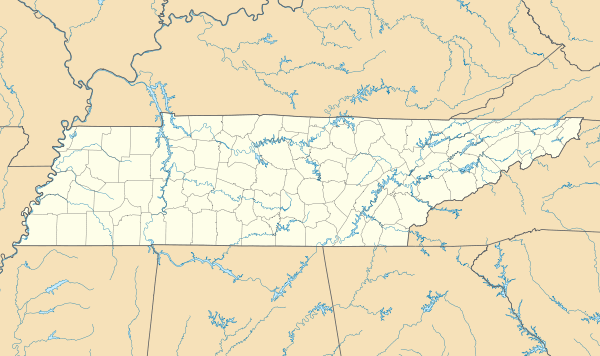Scarritt College for Christian Workers
|
Scarritt College Historic District | |
|
The Wightman Chapel in the Scarritt College Historic District | |
  | |
| Location | 19th Avenue South, Nashville, Tennessee, U.S. |
|---|---|
| Coordinates | 36°8′46″N 86°47′48″W / 36.14611°N 86.79667°WCoordinates: 36°8′46″N 86°47′48″W / 36.14611°N 86.79667°W |
| Area | 1.8 acres (0.73 ha) |
| Built | 1925-1928 |
| Architect | Henry C. Hibbs |
| Architectural style | Gothic Revival |
| NRHP Reference # | 82003965[1] |
| Added to NRHP | August 26, 1982[2] |
Scarritt College for Christian Workers was a college associated with the United Methodist Church in Nashville, Tennessee, USA.
History
The Scarritt College for Christian Workers was started as the Scarritt Bible and Training School in 1892 in Kansas City, Missouri by Reverend Nathan Scarritt.[3][4] It was Belle Harris Bennett, a Methodist worker, who fundraised for the Missouri campus.[5] The President was Methodist minister Jesse Lee Cuninggim.[6]
By 1924, under President Cuninggim's leadership,[6] the college name was changed to the Scarritt College for Christian Workers and it was relocated to Nashville, Tennessee.[7] Architect Henry C. Hibbs, who had designed the campus buildings of the George Peabody College for Teachers, designed the campus buildings in the late Gothic Revival architectural style.[2] Construction of the Belle Bennett Memorial, which included Scarritt Hall, Bennett Hall, Wightman Chapel and the Tower, as well as the Susie Gray Dining Hall began in 1925.[3] Built with Crab Orchard stone, it was completed in 1928.[3] The Wightman chapel was named in honor of Maria Davies Wightman, the wife of Bishop William May Wightman.[8]
By the 1930s, the college "offered a bachelor's degree and graduate education in the fields of community and family service, social work, and religious education."[7] From 1940 to the 1960s, the campus was expanded with the construction of six additional buildings.[3] During the Civil Rights era, Martin Luther King, Jr. spoke in Wightman Chapel.[4] In 1973, J. Richard Palmer, formerly of Berea College was brought in as president to increase fundraising and enrollment.[7] However, he resigned in 1977 due to internal politics.[7]
The college became known as the Scarritt Graduate School from 1981 to 1988.[4] During that time, it was a graduate school for Church Music and Christian Education.[4] Since it closed down in 1988, it has been known as the Scarritt Bennett Center.[4] It is used for conferences.[4]
Architectural significance
Several of its buildings have been listed on the National Register of Historic Places since August 26, 1982. The historic district is made up of the original campus buildings built before 1940: Administration Building, Memorial Tower, Susie Gray Dining Hall, Bennett Hall, and Wightman Chapel.[3]
References
- ↑ National Park Service (2010-07-09). "National Register Information System". National Register of Historic Places. National Park Service.
- 1 2 "Scarritt College Historic District". National Park Service. Retrieved November 27, 2015.
- 1 2 3 4 5 "National Register of Historic Places Inventory--Nomination Form: Scarritt College Historic District". National Park Service. Retrieved November 27, 2015.
- 1 2 3 4 5 6 "Our Story". Scarritt Bennett Center. Retrieved November 27, 2015.
- ↑ "Belle Harris Bennett: American church worker". Britannica. Retrieved November 27, 2015.
- 1 2 "Jesse L. Cuninggim" (PDF). Vanderbilt University. Retrieved November 27, 2015.
- 1 2 3 4 Van West, Carroll (December 25, 2009). "Scarritt College for Christian Workers". The Tennessee Encyclopedia of History and Culture. Retrieved November 27, 2015.
- ↑ Herbert, Walter I. (1928). Fifty Wonderful Years, 1878-1928. Story of Missionary Work by Methodist Women in South Carolina, Methodist Episcopal Church, South. Jubilee Committees of the two South Carolina conferences. p. 88.
External links
![]() Media related to Scarritt College for Christian Workers at Wikimedia Commons
Media related to Scarritt College for Christian Workers at Wikimedia Commons